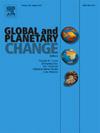Response of carbonate rock weathering carbon sink to seismic peak ground acceleration in China
IF 4
1区 地球科学
Q1 GEOGRAPHY, PHYSICAL
引用次数: 0
Abstract
Seismic peak ground acceleration (PGA) is a key indicator to characterize the strength of seismic effects, which affects the rate of chemical weathering of carbonate rocks and the ability to capture CO2. However, the response mechanism and process of Carbonate rock weathering Carbon Sink (CCS) to PGA are not clear. To this end, this paper clarifies the spatial and temporal patterns of CCS in China and reveals their response to PGA based on PGA, climate, lithology and other datas, combined with methods such as the random forest model and maximal potential dissolution model. The results showed that the CCS Flux(CCSF) was 5.32 t C km−2 yr−1 and the Full CCS (FCCS) was 1346 × 104 t C yr−1, which was influenced by PGA, with the flux being the largest at 0.05 g PGA (5.38 t C km−2 yr−1), mainly in the south-western part of the country where hydrothermal conditions are favourable. Meanwhile, the response of CCS to PGA was affected by latitude and altitude divergence. CCS at the same latitude showed a fluctuating downward trend with the enhancement of PGA. Two trends of CCS and PGA at the same altitude appeared, one was that CCS increased with the enhancement of PGA when the altitude was less than 2500 m as well as 4500–6500 m, and the other was that CCS decreased with the enhancement of PGA when the altitude was 2500–4500 m. At the same PGA, CCS decreased with increasing latitude and elevation, respectively. This may be due to the fact that higher altitude and latitude are associated with lower temperatures, which affects the rate of chemical weathering of carbonate rocks, and hence CCS. The aim of this paper is to understand the response relationship between CCS and PGA, which helps to reveal how geologic activities affect the carbon cycle. The results of the study bridge the gap between tectonic geology and CCS systematic research to a certain extent, and promote the integration of the disciplines. This is of great significance for assessing the potential impact of natural disasters such as earthquakes on carbon sinks.
地震峰值地面加速度(PGA)是表征地震效应强度的一个关键指标,它影响着碳酸盐岩的化学风化速度和捕获二氧化碳的能力。然而,碳酸盐岩风化碳汇(CCS)对 PGA 的响应机制和过程尚不清楚。为此,本文基于PGA、气候、岩性等数据,结合随机森林模型和最大潜在溶解度模型等方法,阐明了中国碳酸盐岩风化碳汇的时空格局,并揭示了其对PGA的响应。结果表明,CCS通量(CCSF)为5.32 t C km-2 yr-1,全CCS(FCCS)为1346×104 t C yr-1,受PGA影响较大,其中0.05 g PGA时通量最大(5.38 t C km-2 yr-1),主要分布在热液条件较好的西南地区。同时,碳捕获量对 PGA 的响应受纬度和海拔差异的影响。同一纬度的 CCS 随 PGA 的增加呈波动下降趋势。同一海拔高度下的 CCS 与 PGA 呈两种变化趋势,一种是当海拔低于 2500 米和 4500-6500 米时,CCS 随 PGA 的增加而增加;另一种是当海拔在 2500-4500 米时,CCS 随 PGA 的增加而减少。这可能是由于海拔和纬度越高,温度越低,从而影响碳酸盐岩的化学风化速度,进而影响碳酸盐含量。本文旨在了解 CCS 与 PGA 之间的响应关系,这有助于揭示地质活动如何影响碳循环。研究结果在一定程度上弥补了构造地质学与CCS系统研究之间的空白,促进了学科融合。这对于评估地震等自然灾害对碳汇的潜在影响具有重要意义。
本文章由计算机程序翻译,如有差异,请以英文原文为准。
求助全文
约1分钟内获得全文
求助全文
来源期刊

Global and Planetary Change
地学天文-地球科学综合
CiteScore
7.40
自引率
10.30%
发文量
226
审稿时长
63 days
期刊介绍:
The objective of the journal Global and Planetary Change is to provide a multi-disciplinary overview of the processes taking place in the Earth System and involved in planetary change over time. The journal focuses on records of the past and current state of the earth system, and future scenarios , and their link to global environmental change. Regional or process-oriented studies are welcome if they discuss global implications. Topics include, but are not limited to, changes in the dynamics and composition of the atmosphere, oceans and cryosphere, as well as climate change, sea level variation, observations/modelling of Earth processes from deep to (near-)surface and their coupling, global ecology, biogeography and the resilience/thresholds in ecosystems.
Key criteria for the consideration of manuscripts are (a) the relevance for the global scientific community and/or (b) the wider implications for global scale problems, preferably combined with (c) having a significance beyond a single discipline. A clear focus on key processes associated with planetary scale change is strongly encouraged.
Manuscripts can be submitted as either research contributions or as a review article. Every effort should be made towards the presentation of research outcomes in an understandable way for a broad readership.
 求助内容:
求助内容: 应助结果提醒方式:
应助结果提醒方式:


